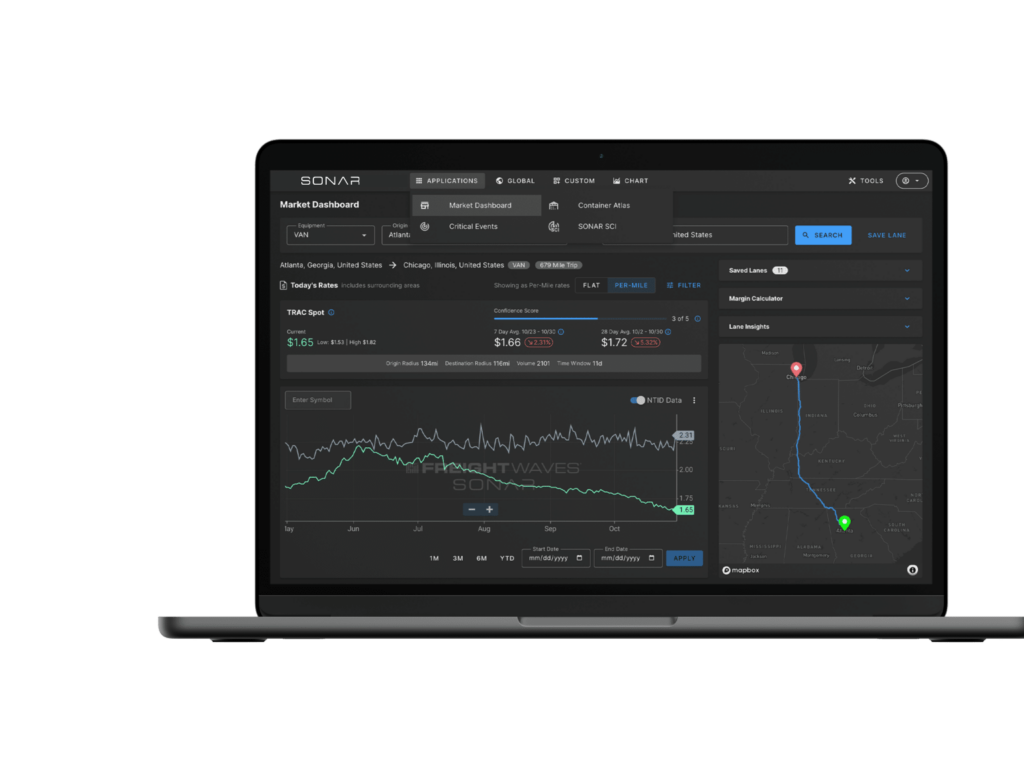Throughout the past two years, brokers have struggled to find external opportunities in spot bidding or RFP environments. When the market is loose as it has been since early 2023, brokers have had to secure rates at break-even or below cost levels in order to win new business, making it hard to scale or achieve their margin or revenue goals in 2024.
One of the ways that SONAR brokerage customers are advancing toward their margin or revenue goals is by analyzing their buy rates against the TRAC (Trusted Rate Assessment Consortium) rates, Confidence Scores and Lane Scores within the Market Dashboard Plus App.
Market Dashboard Plus is a multi-lane management tool that provides context around origin and destination capacity conditions in relation to spot and contract rates. Brokers are able to view current spot and contract rates, variability in the rates, Lane Scores and Outbound Tender Rejections for the origin, which improves their network optimization on the loads they are currently running.
Network Optimization: Opportunities to Increase Margins
Once the lane file has been uploaded into Market Dashboard Plus, broker customers can analyze the data within the UI or export it into a CSV file. The benefits of having the Confidence Score, Lane Scores and OTRI in comparison to the buy rates at which brokers are purchasing can provide a large opportunity for margin adjustments. By coupling the market insights along with rate-per-mile deltas, SONAR customers can make informed decisions regarding their buy rates. Several customers have capitalized on opportunities of anywhere from $20,000 over a five-week period to upwards of $120,000 for the same time frame.
Confidence Scores
Many brokerage customers input their buy rates for each lane into the exported file, along with some simple calculations to determine the RPM delta between their rates and the TRAC rates. Using those deltas, SONAR customers can target lanes that have low variance in pricing, which provides a starting point for analysis of the easiest lanes to cover. The Confidence Score for each TRAC Rate indicates the dispersion or variance of rates and the given volume for a particular lane. A high Confidence Score, 3 or better, indicates that the rates returned on that lane are tightly clustered around the average rate.

Lane Scores
Outside of the Confidence Score, SONAR brokerage customers consider the Lane Score to measure the balance of the flow of capacity relative to other lanes in current market conditions using a scale of 0-100. A low Lane Score indicates the flow of capacity into a given market is inbound-centric, while a high Lane Score indicates the flow of capacity is more outbound-centric. It is recommended that brokers also consider a lane score of 40+ (neutral or better) when putting pressure on buy rates, as lanes with a lane score of 40+ are considered more desirable by carriers due to the inbound and outbound load balance of those markets compared to others. Every network is different, however, so there may be opportunities to purchase capacity closer to the market rate on loads with a Difficult or Most Difficult Lane Score, depending on the carrier base and relationships between the broker and their capacity providers.

SONAR brokerage customers are working toward their margin or revenue goals by analyzing their buy rates against the TRAC rates, Confidence Scores and Lane Scores within the Market Dashboard Plus App. By identifying lanes with low pricing variability and a preferable balance of capacity flow, brokers are able to capitalize on opportunities for getting more margin in the door on the freight they are already running.
If you are a current SONAR customer that is interested in learning more about lane level analysis in Market Dashboard Plus, reach out to your customer success manager or email [email protected].
Not a SONAR customer? Get in touch with one of our experts here.










